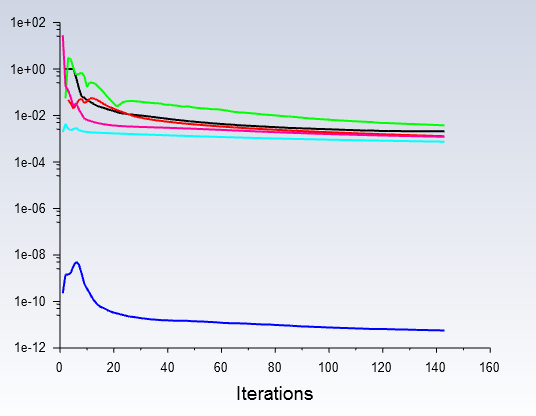-
-
February 1, 2021 at 2:21 pm
Moussa
SubscriberHi,
I am currently modeling transient natural convection of a liquid inside a tank but my simulation doesn't converge using SIMPLEC algorithm as mentioned in the article.
February 1, 2021 at 2:48 pmRob
Forum ModeratorDo you have a gas phase present too? Mesh (and cell) quality and time step are more likely to be causing the problems. nFebruary 1, 2021 at 3:00 pmFebruary 1, 2021 at 3:53 pmFebruary 1, 2021 at 4:02 pmDraxler
SubscriberDid you change the Residual values to a smaller number than the default? nMost youtube videos change them to 10-6 and I was doing that as well. For very simple geometries, this works, but for complex ones, I was also having a problem with converging. I changed them back to 10-3 and the solution did converge. nSmaller residuals lead to more accurate results as far as I know. But in my comparison of the 2, there was very little difference.nnFebruary 1, 2021 at 4:11 pmRob
Forum ModeratorGiven the SIMPLEC has only done 140 iterations you may want to try running it on. Also note, the PBCS solver uses a courant number or time factor so may converge better if you've not adjusted any of the under relaxation defaults. nFebruary 1, 2021 at 4:25 pmMoussa
SubscriberThank younThe energy residual is falling under e-11, for the sufficient convergence of the iterative solutions, they use e-10 for the energy equation and e-0u00035 for the other conservation equations.nThe results at the initial state (t = 0) are obtained from the steady-state calculation at ptank = 1atm ( temperature contours posted earlier), there is a big difference between the two algorithms.n Residuals using SIMPLEC algorithm in steady-state simulation.nn
February 1, 2021 at 4:28 pm
Residuals using SIMPLEC algorithm in steady-state simulation.nn
February 1, 2021 at 4:28 pmRob
Forum ModeratorWhich isn't converged. Try dropping the momentum under relaxation factor. What density model are you using?nFebruary 1, 2021 at 4:52 pmFebruary 2, 2021 at 3:15 pmMoussa
SubscriberAny advice? Thank you in advance.nFebruary 2, 2021 at 4:01 pmRob
Forum ModeratorI'd be more worried about the continuity equation in the first case. Given PBCS uses a time factor I suspect that's why the convergence is better. Converge the first case properly and then compare the results. nViewing 10 reply threads- The topic ‘Natural convection in a pressurized storage tank’ is closed to new replies.
Innovation SpaceTrending discussions- air flow in and out of computer case
- Varying Bond model parameters to mimic soil particle cohesion/stiction
- Eroded Mass due to Erosion of Soil Particles by Fluids
- I am doing a corona simulation. But particles are not spreading.
- Centrifugal Fan Analysis for Determination of Characteristic Curve
- Issue to compile a UDF in ANSYS Fluent
- Guidance needed for Conjugate Heat Transfer Analysis for a 3s3p Li-ion Battery
- JACOBI Convergence Issue in ANSYS AQWA
- affinity not set
- Resuming SAG Mill Simulation with New Particle Batch in Rocky
Top Contributors-
4432
-
1494
-
1376
-
1209
-
1021
Top Rated Tags© 2025 Copyright ANSYS, Inc. All rights reserved.
Ansys does not support the usage of unauthorized Ansys software. Please visit www.ansys.com to obtain an official distribution.
-
The Ansys Learning Forum is a public forum. You are prohibited from providing (i) information that is confidential to You, your employer, or any third party, (ii) Personal Data or individually identifiable health information, (iii) any information that is U.S. Government Classified, Controlled Unclassified Information, International Traffic in Arms Regulators (ITAR) or Export Administration Regulators (EAR) controlled or otherwise have been determined by the United States Government or by a foreign government to require protection against unauthorized disclosure for reasons of national security, or (iv) topics or information restricted by the People's Republic of China data protection and privacy laws.
























